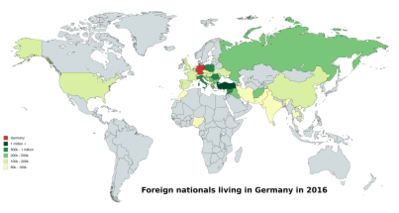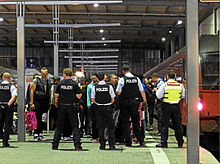| German citizenship and immigration |
|---|
| |
| Immigration |
| Citizenship |
| Agencies |
| History |
Immigration to Germany, both in the country's modern borders and the many political entities that preceded it, has occurred throughout the country's history. Today, Germany is one of the most popular destinations for immigrants in the world, with well over 1 million people moving there each year since 2013. [1] As of 2019, around 13.7 million people living in Germany, or about 17% of the population, are first-generation immigrants. [2]
Contents
- History of immigration to Germany
- Pre-unification
- After World War II until reunification (1945–1990)
- 1990–present
- Immigration regulations
- EU citizens
- Immigration options for non-EU citizens
- Student visa
- 2023 immigration reforms
- Context and response to 2023 reforms
- Agreement with Kenya
- Asylum seekers and refugees
- Naturalization
- Immigrant population in Germany by country of birth
- Comparison with other European Union countries 2023
- Crime
- Poverty
- See also
- References
- Further reading
- External links

Even before Germany's formal founding in 1871, its predecessor states, such as the Holy Roman Empire and the German Confederation, were common destinations for the persecuted or migrant workers. Early examples include Protestants seeking religious freedom and refugees from the partitions of Poland. Jewish migrants, mostly from Eastern Europe, was also significant in successive waves. In the 20th century, rising antisemitism and xenophobia resulted in the mass emigration of German Jews and culminated in the Holocaust, in which almost all remaining German Jews and many other religious or ethnic groups, such as German Roma, were systematically murdered. In the decades since, Germany has experienced renewed immigration, particularly from Eastern and Southern Europe, Turkey and the Middle East. [3] Since 1990, Germany has consistently ranked as one of the five most popular destination countries for immigrants in the world. [4] According to the federal statistics office in 2016, over one in five Germans has at least partial roots outside of the country. [5]
In modern Germany, immigration has generally risen and fallen with the country's economy. [6] The economic boom of the 2010s, coupled with the elimination of working visa requirements for many EU citizens, brought a sustained inflow from elsewhere in Europe. [7] Separate from economic trends, the country has also seen several distinct major waves of immigration. These include the forced resettlement of ethnic Germans from eastern Europe after World War II, the guest worker programme of the 1950s–1970s, and ethnic Germans from former Communist states claiming their right of return after the breakup of the Soviet Union. [8] Germany also accepted significant numbers of refugees from the Yugoslav wars in the 1990s and the Syrian civil war in the 2010s.
Motivated in part by low birth rates and labour shortages, German government policy towards immigration has generally been relatively liberal since the 1950s, [9] although conservative politicians resisted the normalization of Germany as a country of immigrants and citizenship laws accordingly remained relatively restrictive until the mid-2000s. A major reform of immigration law in 2005 saw the state commit, for the first time, resources to the integration of newcomers and significantly liberalised the labour market for skilled professionals while restricting it for unskilled labourers. [10] Smaller immigration reforms in 2009, 2012 and 2020 contributed to the broad trend of liberalisation. [10] The 2021 federal elections saw the formation of a center-left government which promised to reform immigration law. [11] In 2023, the coalition began implementing a series of reforms including the Skilled Workers Immigration Act (in German, Fachkräfteeinwanderungsgesetz, or FEG) [12] that among other things eased requirements for foreign workers, [13] relaxed naturalization requirements [14] and legalized multiple citizenship. [14]






